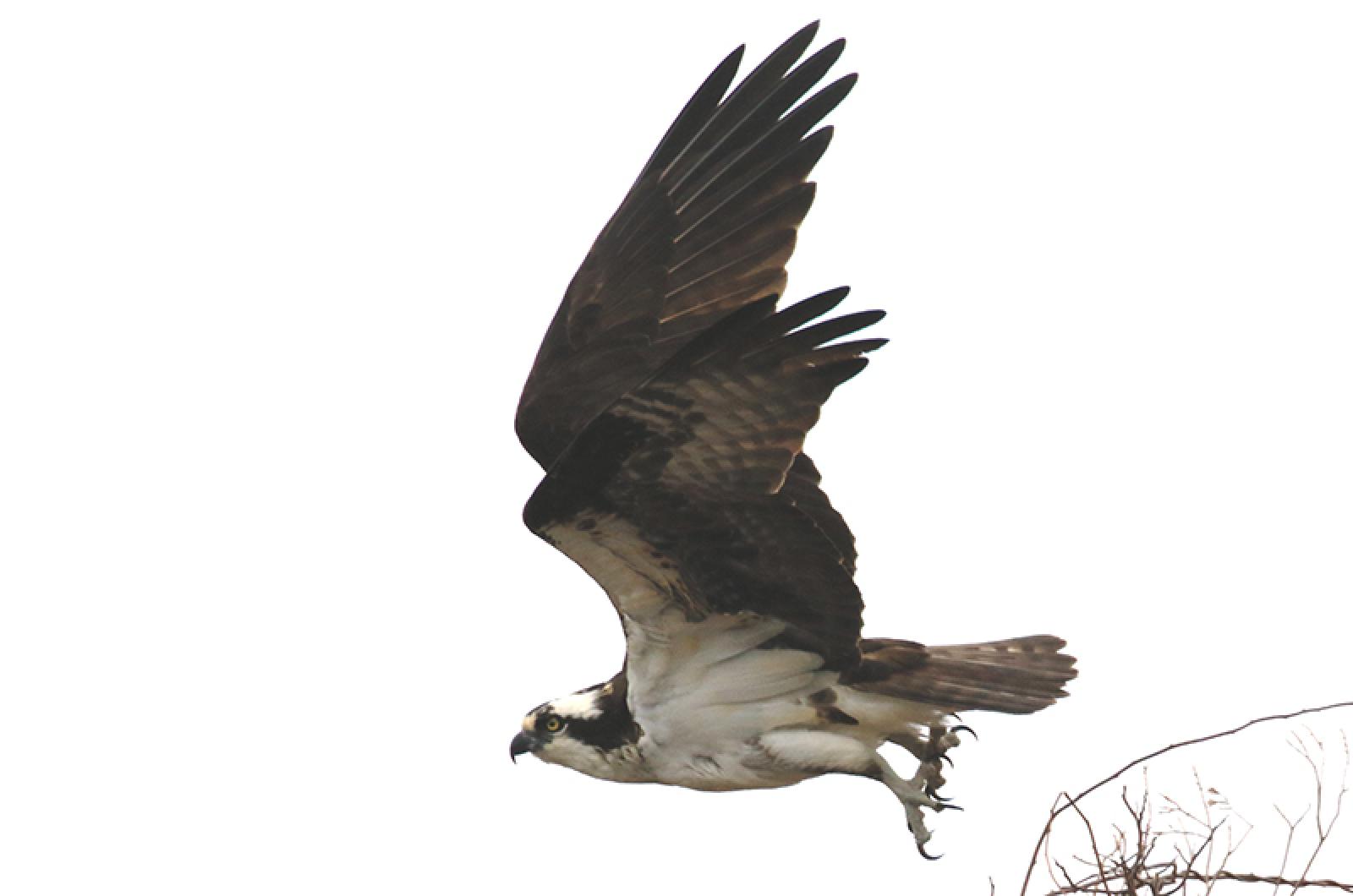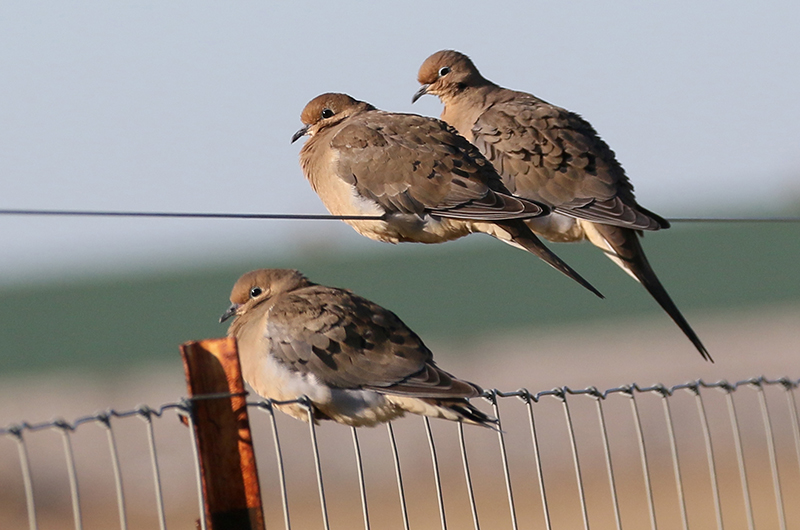It is March and, as expected, the pace of the northward migration has increased. Warm temperatures and southwesterly winds brought a variety of birds northward. Can spring and summer be far behind?
Perhaps one of the most anticipated arrivals is that of the osprey. Long-time osprey observer Dick Jennings spotted the first osprey of the season near the hospital on March 14.
Two of our nesting shorebirds arrived this week. A showy American oystercatcher, complete with its bright red bill, was spotted by Vasha Brunelle along the shores of Lagoon Pond near the Tisbury Marketplace on March 14, and I heard and then saw the bird the next day. We had a sighting of an oystercatcher in February, but that was so early that most likely it was an overwintering individual. The second species was a lone male piping plover spotted by Hans Goeckel on March 15 at the eastern end of Norton Point Beach.
We have not had a snow goose sighting since last spring. A flock of six blue phase snow geese showed up at the Farm Institute on March 14, and were seen by Bob Shriber, Jeff Bernier and Lanny McDowell. Elsewhere, Allan Keith found a single immature blue goose on a small pond near the road to Squibnocket Beach. Mr. Keith also reports the arrival of an eastern phoebe at his farm on March 14.
A large flock of migratory robins showed up in Gus Ben David’s yard on March 15. He also reports that a second yellow-rumped warbler has joined the single individual that has been there all winter.
That makes seven species arriving on those two days!
Waterbirds are also on the move. Viewing conditions were excellent (cloudy and near flat calm seas) and Allan Keith estimates that there could well have been more than 200 razorbills off Aquinnah on March 12, as both he and Bob Shriber saw 100 from slightly different locations. Albert Fischer observed two lesser scaup on Squibnocket Pond on March 12. And on March 9, Jeff Bernier spotted a pair of ring-necked ducks on one of the ponds near the Wakeman Center, while Allan Keith found a pair of them on nearby Duarte’s Pond.
Yet another sign of the coming spring is nest building by mourning doves. Their nests are so sloppy that it looks like their eggs will fall through, but that cannot happen too often judging by their abundance. Matt Pelikan observed two doves constructing their nest on March 14 in his Oak Bluffs yard.
Bob Shriber spotted an American pipit in a Katama field on March 8.
The white-fronted goose was seen again by Allan Keith in Katama on March 12, and he also spotted one of the short-eared owls. Scotty Goldin spotted two northern harriers foraging over the Katama Plains on March 15.
There have been weekly bald eagle sightings for most of the winter. Nancy Weaver and Margaret Curtin spotted a juvenile bald eagle near the Oak Bluffs Pumping Station on March 13 (they also spotted a hermit thrush under a nearby white pine). Warren Gossen spotted a juvenile bald eagle near Eastville Point Beach on March 10, and that same day Brian Packish spotted one circling above Farm Pond. And on March 14, Wendy and Anne Culbert and I spotted a distant eagle soaring above the southern end of Menemsha Pond.
Great Backyard Bird Count
The Great Backyard Bird Count is an annual international event that took place this year from Feb. 14 to Feb. 17. Almost a quarter of a million checklists were submitted and 6,942 species were observed. Our totals for the Vineyard were 11 observers submitting 34 checklists for 2,522 individuals of 73 species and one additional subspecies (savannah (Ipswich) sparrow). This event is not as structured as the Christmas Bird Count, so some locations were visited by more than one observer; care was taken to avoid counting a bird twice.
The results of The Great Backyard Bird Count are:
Canada goose 178, mute swan 8, gadwall 17, American wigeon 8, American black duck 226, mallard 76, northern pintail 8, green-winged teal 4, greater scaup 4, common eider 136, harlequin duck 8, surf scoter 29, white-winged scoter 8, black scoter 135, scoter species 3, bufflehead 214, greater scaup 4, common goldeneye 45, hooded merganser 18, red-breasted merganser 62, wild turkey 1, red-throated loon 1, common loon 31, great cormorant 19, great blue heron 3, turkey vulture 5, northern harrier 1, Cooper’s hawk 1, bald eagle 1, red-tailed hawk 7, black-bellied plover 12, sanderling 17, ring-billed gull 12, dunlin 41, herring gull 509, lesser black-backed gull 1, great black-backed gull 68, rock pigeon 25, mourning dove 27, belted kingfisher 1, red-bellied woodpecker 8, downy woodpecker 13, hairy woodpecker 6, northern flicker 3, northern shrike 1, blue jay 14, American crow 67, horned lark 4, black-capped chickadee 71, tufted titmouse 29, white-breasted nuthatch 19, brown creeper 2, Carolina wren 6 golden-crowned kinglet 2, eastern bluebird 14, hermit thrush 1, American robin 14, European starling 27, western palm warbler 1, pine warbler 1, yellow-rumped warbler 1, yellow-breasted chat 1, chipping sparrow 1, dark-eyed junco 55, white-throated sparrow 5, savannah sparrow 8, savannah (Ipswich) sparrow 4, song sparrow 20, swamp sparrow 2, northern cardinal 19, common grackle 4, house finch 16, American goldfinch 7, house sparrow 2.
North-bound migrants are arriving! Please report your sightings to birds@mvgazette.com.
Robert Culbert is an ecological consultant with Nature Watch LLC living in Vineyard Haven.









Comments
Comment policy »